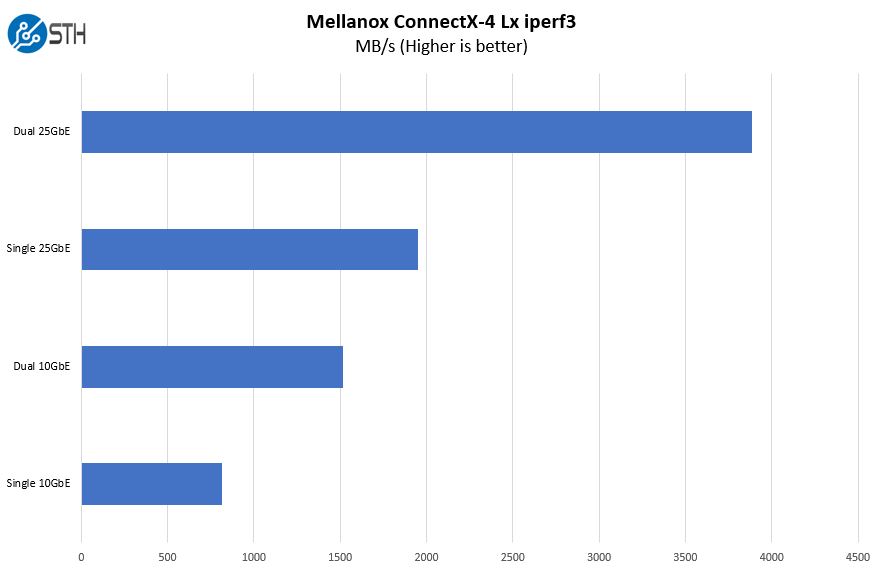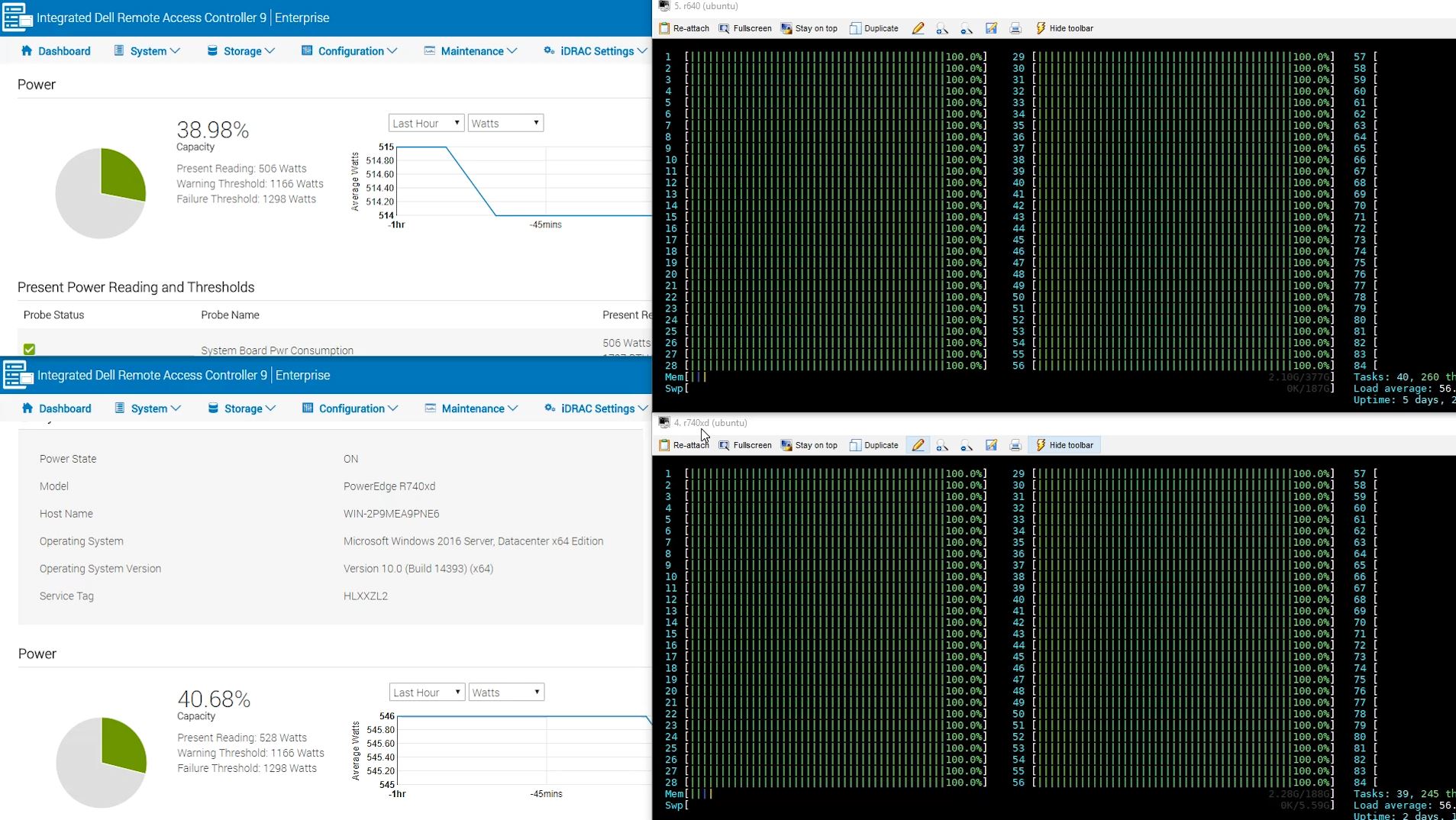Dell EMC PowerEdge R740xd Networking
Our test system was had Mellanox ConnectX-4 Lx dual 25GbE adapter. With this generation, SFP28 25GbE is a cost-effective upgrade from 10Gb SFP+ offering effectively 2.5x the performance of the legacy standard.

We verified that the 25GbE adapter linked at both 25GbE and 10GbE speeds via our Dell Z9100-ON 100GbE switch and our Arista/ Quanta QCT 10GbE/ 40GbE legacy switch infrastructure. For those who have legacy 10GbE networking, the 25GbE ports worked without issue even with SFP+ DACs and breakouts to our switches. We ran a quick test for throughput using iperf3 running out of the box on our network at 10GbE and 25GbE speeds:

With the Intel Xeon Scalable generation, one can achieve higher VM density and aggregate more storage I/O than with previous generations. 100GbE port shipments have passed 40GbE port shipments so it is time to adopt the 25GbE standard in endpoints, especially as it is backward compatible with legacy 10GbE infrastructure. This is one area where we can suggest future proofing your servers with confidence.
We would have liked to have seen a 100GbE LOM option but you need PCIe 3.0 x16 so using an add-in card is reasonable.
Dell EMC PowerEdge R740xd Power Consumption
Our Dell EMC PowerEdge R640 came equipped with dual 1100W power supplies. This is important for the dual Xeon Platinum 8180’s that can use over 700W combined with AVX-512 workloads.
One test result that we found particularly interesting was running the PowerEdge R640 and R740xd side-by-side. Both had Dell’s 1.1kW PSUs and were configured with the same Intel Xeon Platinum 8180 and the same SSDs. In a non-AVX-512 workload that we pinned on all 28 physical cores on each CPU, the Dell EMC PowerEdge R640 actually showed slightly better power consumption figures.

We highlighted this result in Testing Conventional Wisdom in 1U v 2U Power Consumption but there was a major difference. The test Dell EMC PowerEdge R740xd had additional circuits to light more drive bays with SAS3 and NVMe so our result makes sense. The great thing is that we were able to monitor power consumption using not just our Schneider Electric PDUs but also through iDRAC. In this particular case, we could use iDRAC’s API to profile the workload on two different server models deployed in a data center, and then pick the platform that provided the best power efficiency. Dell’s iDRAC even computes the BTU/hr figures so one can aggregate that information and manage racks and data center cooling. That is an awesome capability.
During AVX-512 workloads and the Intel Xeon Platinum 8180’s we hit over 700W consistently with the system. With the dual Intel Xeon Bronze 3106’s we stayed under 295 so there are a lot of opportunities to customize the power consumption. What is more, the Dell EMC PowerEdge R740xd supports multiple GPUs, including multiple double-width GPUs so power consumption is going to vary significantly based on configuration. At the same time, if you are sizing your rack power needs, you are unlikely to need as much power as the PSU power rating for a server.
Final Words
If you have stayed with us on this journey, you have seen a complete review of the Dell EMC PowerEdge R740xd. We covered the physical hardware and how Dell’s engineering team is able to squeeze features and versatility into just about every corner of the chassis while still making it serviceable. We showed how iDRAC 9 provides a fast and complete server management platform that serves as a hub for system data that can then be queried and managed by datacenter level tools as well. We showed how several processors throughout the Intel Xeon Scalable range perform in the Dell EMC PowerEdge R740xd and the impact of moving up the CPU stack. We showed the storage and networking performance including a Dell unique SAS3/ NVMe solution and trending 25GbE networking. Finally, we showed how all of this performance equates to ongoing power and cooling costs in your data center.
At the end of numerous CPU swaps and teardowns, we can say this: the Dell EMC PowerEdge R740xd embodies unbridled versatility. Having so much hands-on time you can see how small improvements over generations of PowerEdge have manifested themselves into a platform with usability and features well beyond what white box competitors can offer. If you are a Dell shop and are trying to figure out if you should buy this box, the answer is yes. If you are not a Dell shop and are looking for an excellent server experience, this review showed why Dell EMC PowerEdge R740xd should be atop your list.




This is the most in-depth review I’ve ever seen on a server and 10x better than whitepapers. I really like that you went into performance with so many different CPU options. You could have said though that slower bronze and silver CPUs can’t use ddr4-2666 because of Intel’s limitation. You’ve still got a massive amount of information in here. I’m going to read again tomorrow and share with our team.
Holy hell. What a review. We’ve got a few racks of these already. I’d wholeheartedly concur.
It took me 32 minutes to read. You can almost turn this into a Kindle book but the pictures would suck. Really good STH. For me those servicing pics stand out and I’m normally a Lenovo admin. Maybe it’s time to look.
With the first few sentences I thought ‘wait.. 1U? It’s a 2U machine!’ :P
HC node for sure. I’d echo the thoroughness comments. You’ve got everything here.
Maybe you can do a video next time?
Read pages 1 and 2. Coffee break. Read pages 3-5. Lunch. I agree you’d be better off turning this into a Kindle book.
This is an awesome high quality review! Really good job STH.
Is this with SSD or only with SAS or SATA?